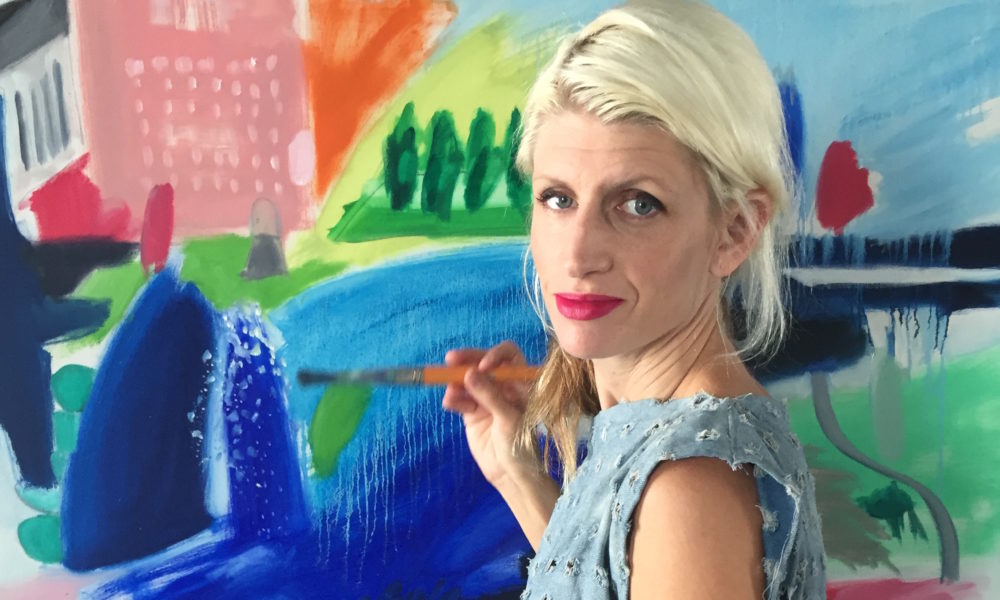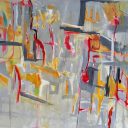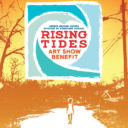I met artist Jamie Zimchek this winter at a bonfire in Grayton Beach and was delighted to discover her works that are currently hanging at the Newbill Collection in Seaside in Ruskin Place Arts District. Ruskin Place made its first international debut in the Truman Show and is the geographical center of Seaside, which in some respects makes it the epicenter for the arts of Scenic Highway 30A.
Seaside town planner Andres Duany explains, “We designed two types of commercial places at Seaside. There is the big Central Square which has the ground floor of the buildings with the retailers centrally recruited, and managed; and then there is Ruskin Place which we designed as live-work housing in which the individual owners could lease their ground floor to commercial use. It is remarkable that these live-work units, without being managed, ended up being art places and Ruskin became the first arts district on 30A. This means that there was a tremendous pressure for the arts which could not recognized by conventional retail analysis. I suspect that we can learn from Ruskin Place the lesson that there really could be support for more art galleries up and down 30A – more real art and less tourist kitsch could yet salvage the reputation of this great beach.”
It’s no wonder that Zimchek found her way to Ruskin Place when she moved to the area last year. Her nomadic instincts, love for design and history-oriented background heavily inform a multi-media approach to her art that lends a fresh perspective to our art laden towns. Zimchek was born near Sacramento, California in 1978. She received a BA in Humanities at Newbold College in the UK in 1998, and her MA in Middle East & Mediterranean Studies from King’s College London in 1999. She worked as a freelance photographer, journalist, and college lecturer in both the U.S. and the U.K., supplemented by extensive solo travels through Asia, Africa, the Caribbean, South America, and Europe, before returning to the United States nearly a decade later. Her travel photography and writing have appeared in international magazines, newspapers, and online travel guides; her graphic design work included commissions from the Ethiopian Ambassador to the US. She has painted in oil since her late teens, but it wasn’t until 2008 that she truly transitioned to fine art alone.
My particular interest in her work is this artist’s unique painting style, which she refers to as “narrative abstracts.” Pulling from her experiences as an academic, traveler and writer, she’s created works that are a cerebral synthesis of ideas, memories, and social constructs. On a subtle level, Zimchek’s mixed-media paintings aim to ask necessary questions -often playfully- about identity and place while offering a sometimes oblique critique of modernity. More overtly, her works are colorful abstract urban landscapes, a mix of brushwork and mark making, with clues to interpretation secreted away for the discerning.
I’m curious and ever hopeful that she will feel inspired to paint narrative abstracts of our new urbanist gems along 30A.
What is your perspective of our town and the current art scene? I think it has great potential. There are some very successful artists and designers here already, but there’s certainly room for more. Selfishly, I’d love to see the area begin to pull in more visitors and permanent residents from farther afield simply because I believe that diversity and a little change can be all that’s needed to spark a creative fire. Last year this area had over 3.5 million visitors, a good share of them from nearby states, which is absolutely lovely, but it would also be nice expand the pool.
What is the critical role of art in our setting? It depends on whether you mean critical in the sense that it points out flaws or critical in that it’s essential. It’s horribly cliche, but the arts really do breathe soul into a place, and in one such as this, where the permanent population is heavily outnumbered by the visiting one, I think it’s easy to lose sight of community without something like the arts to anchor it. So yes to art playing a critical role in that sense, but yes also in the sense that art which challenges existing mores is also necessary here to prevent the creative community from stagnating.
What is the role of the architecture as the dominant art–which is so intensely established in these three towns of 30A–in relation to the other visual arts—and perhaps the performing arts, and literature? New Urbanism has helped put the 30A communities on the map, but it’s more than just town planning, it’s a blueprint for something bigger. The way I understand it, New Urbanist communities were designed to be a well-considered mix of public and personal spaces that emphasized diversity, accessibility, and connectivity. When it comes to architecture more specifically, my experience (as an enthusiast of good design) has led me to believe that as is often the case with significant architecture, and good art (in all forms) that there is a certain level of public-access that allows for personal engagement (I think it’s a great shame the Seaside Pavilions aren’t open to the public for this reason). But done well they’re all linked – an innovative museum design is only an empty form without art, its function, and I think that’s important to remember. One of my favorite places here is Ruskin Place, which balances a public garden space with galleries, boutiques, and private residences beautifully. It’s walkable, it’s a mixed-use space, and importantly, it has that special something that makes the idea of New Urbanism so attractive. I think you can’t overlook the fact that the galleries here, with a scope that ranges stylistically from abstract to folk art and back again via realism, contribute something very important to what is an already well-designed idea. So in short, architecture or the arts can certainly exist without the other, but done right, they can be far more impactful together.
What might art be in a place that is both intensely regional in the way that the American South can be—and yet is also inhabited by cosmopolitan visitors? That’s a tough one. I read an article recently that said one of the best ways to prevent your brain from atrophying with age was to really push it to the point that you’re thinking so hard it almost hurts. So maybe one could make an analogy here and say that while this region has a very rich heritage, growth, of the kind that really shakes us out of our comfort zone, could actually make us (and this place) stronger and more resilient – dare I say – better. So I see art in this area as being at its best when it’s informed to some extent by what has come before, but then works diligently to draw in those cosmopolitan visitors to improve upon what’s already here – mix it up a little, make it exciting – while simultaneously increasing a sense of community, both on a micro and macro scale. I came across another piece that described the Florida panhandle as “culturally conservative” – there are many facets to conservatism, but this was a term I’d never heard before. So really the answer to this question hangs on whether one considers being culturally conservative a good thing or a bad thing.
Is such a thing as an art movement possible today—or is art altogether about individual expression. Might this be a place so specific in character that a new urbanist art movement can be incubated? That’s another hard question! The term “art movement” is so subjective. If you were thinking of it in terms of a proper Renaissance, I think no, it’s not. There’s not the right ratio of chaos to creativity and too much connectivity in this day and age. But on a smaller scale, maybe. I was reading through some articles considering New Urbanism and art lately – because New Urbanism has such an emphasis on community, it seems like good public art – whether it’s painting, sculpture, or performance art (with a nod to the thriving theater scene already in place here) plays an important role within that framework. So if I were to imagine what any kind of art movement connected to New Urbanism would look like, it would be diverse, connected, and thought-provoking while drawing people into a discourse that covers everything from urban planning to history to social change to culture and so forth. The painful part of this is that while acknowledging art has its place as something aesthetically appealing, good art should (I think), go a step beyond and make people think. And I mean think beyond the immediate thought that the artwork in question would look nice over an armoire. It’s almost as though we’ve allowed ourselves two categories for art – one category is easily accessible and what we tend to hang on our walls, the other is a call to action, it challenges. Both have their role, but one pushes boundaries and has the potential to incite change on some level, often subtle, in ways the other doesn’t.
With popular tourism and modernity arriving every day more in our precious places, how might it be possible to avoid the descent into kitsch? Do you think it’s possible to avoid completely? I think a full-on descent into kitsch is possible, but the reality is that on some level, kitsch will always be there lurking at the edges. More importantly the question might be, is there room for kitsch to co-exist with something loftier? Sometimes the contrast might provide needed context for understanding the shades of gray between black and white.
What institutions and programs should these towns nurture to foster a healthy culture which includes the arts? From what I’ve observed, the Cultural Arts Alliance has a robust events calendar, and does an excellent job of bringing art to the community. However, it also seems like there could be room for some sort of facility more central to 30A (i.e., biking distance) like the Parrish Art Museum in The Hamptons that could serve as a more readily reachable “public” art space that played host to curated art exhibits, as well as work by local artists, and even offered art classes and other enrichment programs timed to coincide with a week-long vacation stay. There have been other atmospheric seaside communities that have managed this, and it seems like something that could both nurture the region’s considerable assets, cultural or otherwise, and encourage a more diverse discourse that would only enhance South Walton County’s draw as a well-rounded arts destination.
For Thirty-A Review; Photo: Hunter Zimchek-Howells





